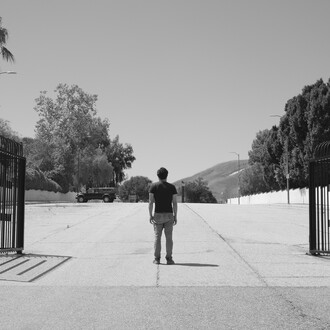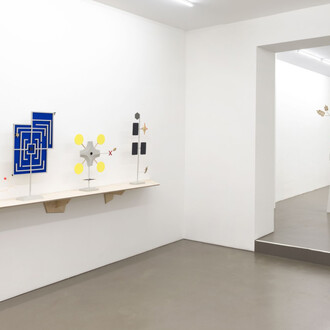The installation seizes us as we enter the room, inviting introspection through its penetrating atmosphere. With its raw concrete walls and opaque glass, the exhibition space offers a perfect setting for Elizabeth Jaeger’s sculptures. Here we find the artist’s favored materials: metal and ceramic, and her recurring motifs: animals, humans, and plants.
On the floor, metal tubes are arranged along lying rectangles. Their dimensions and their alignments evoke graves, and summon every cemetery in the world. Silence imposes itself; contemplation is called for. To the vertigo of American cemeteries, where graves stretch as far as the eye can see, the work responds with an ascending movement. Ceramic flowers are erected along the rectangles. At first very short, their stems gradually lengthen, they rise little by little, until they reach human height. They seem to form a wave, a wave in whose swell we are carried along. We feel the power of the elements and the imminence of catastrophes to come, repeating those of the past. Like the perpetual ebb and flow of the oceans, wars never cease, tirelessly killing, again and again.
The flowers, symbols of delicacy and ephemeral life, remind us of the fragility of the human body—men, women, children—whose lives can be destroyed by a single, tiny metal bullet. To their growing height we associate the vertiginous accumulation of lives cut short, the accumulation of lives swept away while others gorge themselves on money and power. And we, meanwhile, go about our affairs, powerless to act, silenced, rendered cowardly, rendered weak.
Rising from the graves against all odds, fused with the dead whose flesh they have assimilated, these flowers call on us to commemorate them, to remember them, to not give up. Their ascending movement now testifies to the growing sense of revolt against the horrors of which we are capable. From the wave of flowers comes the crash of a raging sea. A glimmer of hope emerges. Despite the failure of flower power movement, does the struggle for the right to live in peace continue? Do we hear the anger of the people, the awakening of the living? Bowed heads rise again; fists are raised again. Will they know, will we know, how to escape brutality? Nothing is less certain, for these fine-stemmed flowers remain fragile, fragile like the fired clay of which they are made. As after the passage of a black tide oil spill, they struggle to breathe, they struggle to multiply.
In front of this scene, like a Sphinx, stands a double figure: wolf dog and human. Sculpted alone, the animal might have evoked the eternal companion, the faithful companion, watching over our dead. That alone would have nourished our hope that humanity, battered and misled, might rise again from its ashes, at last at peace.
Yet combined with the human figure, the work carries us elsewhere. To the feeling of security inspired by the good dog, a glimmer of unease is added; doubt creeps in. What scene are we witnessing? Is the animal that towers over the human figure trying to protect it from unseen aggressors, the piece reflecting the insecurity of our daily lives? Or is it seeking to warm its companion? Despite the proximity suggested by the similar blue of their eyes, their gazes, fixed straight ahead, do not meet. We think of interpersonal relationships, of the always aborted attempts to connect. And the essential solitude of human beings is brought back to us.
Doubt assails us again. Is this caress or struggle? Is the hand on the animal’s head on the verge of pressing into the dog’s eye, in a final gesture of defense before succumbing to its attack? If we look closely, the human face seems frozen, expressionless, the body stretched out as if in its final resting place.
From the horrors of war our thoughts slip toward the sadly common violences of everyday life. The wolf dog could represent the figure’s double, its animal side rendered by the artist. Their intertwined bodies merge until we no longer know to whom the appendage between the legs belongs. It evokes the wild side of relationships, where the best collides with the worst, where fears breeds intolerance and aggression, where blows rain down, sometimes pretending to be love. The flowered graves would then stand for the countless lives cut short for being different—by sex, by color, by gender identity, by sexual orientation, by religion. Of the human figure, we cannot even say if it is man or woman, and this ambiguity contributes to the power of the work, to its universal scope.
The figure’s silver color seems to lift it out of the scene, placing it in another space and time. Nightmare: are we plunged into its dream, into its nocturnal thoughts freed from censorship, to the point of permitting carnal union with its canine companion? For sexuality, and with it life, vibrates everywhere. It bursts forth in the roar and movement of the waves, it diffuses through the erect stems of the flowers, through their pistils standing at the center of blossoming crowns of petals. Two survivors fighting through their union against the reign of death. Unless this monstrous, sterile closeness embodies the most terrible of our collective nightmares: chaos, the imminent end of all humanity. Rarely has an artist’s work seemed to me to hold such depth, such layers of resonance with its audience.
Elizabeth Jaeger’s works seem to grasp something of the very essence of our human matter and our bonds. Here we stand before our contradictory impulses, our fundamental anxieties, our desires, our love and our hate. Through the intensity and strangeness radiating from her works, the artist compels us to think, and stuns that thought just enough to release sensation, sensuality, and fantasy. She summons our collective imagination and representations, our symbols, our rites, our mythology. She reawakens what we try to bury, and the work resonates within us, even to the point of playing with us. If we are willing to let go, we find ourselves carried back and forth, tossed between Eros and Thanatos, toward what is ungraspable, toward the inaccessible in ourselves and in others. Only certain experiences in life allow such journeys to the depths of intimacy, and sometimes the encounter with particular works of art.
(Text by Lina Ziadé)
















